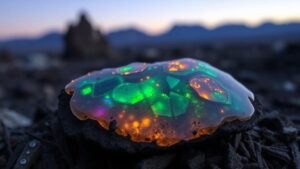The Hunt for Moldavite: Unearthing Rare Impact Glass Formed by Cosmic Forces
The Hunt for Moldavite: Unearthing Rare Impact Glass Formed by Cosmic Forces
Moldavite, a fascinating and enigmatic gemstone, is a type of natural glass believed to have formed from the violent impact of a meteorite colliding with Earth approximately 15 million years ago. Found primarily in the regions of the Czech Republic, this gem is highly sought after by collectors and rockhounds alike. Its unique origins, striking color, and distinctive characteristics make it a captivating subject for enthusiasts. This article explores the history, formation, characteristics, and collection tips for moldavite, providing a comprehensive guide for anyone interested in this extraordinary impact glass.
The Formation of Moldavite
The origins of moldavite can be traced back to a significant meteorite impact known as the Ries crater event, located in southern Germany. When the meteorite struck the Earth, the intense heat and pressure caused the surrounding silica-rich rocks to melt and vaporize, forming a hot, molten glass. This newly formed glass was ejected into the atmosphere, where it cooled rapidly, resulting in the distinctive greenish hue that moldavite is known for.
Scientific studies have revealed that moldavites composition includes about 70% silicon dioxide (SiO2), along with trace amounts of aluminum, magnesium, and iron. Most moldavite specimens exhibit a color range between olive green and bottle green, with some rare examples showcasing a deeper, almost translucent shade. The average size of moldavite pieces varies, though they typically range from small chips a few grams in weight to larger specimens weighing several ounces.
Characteristics of Moldavite
Identifying authentic moldavite can be an exciting challenge for collectors. Here are some distinguishing features:
- Color: Moldavite is primarily green, with variations that can include brownish-green and yellow-green hues.
- Surface Texture: Genuine moldavite often has a unique, pitted surface known as brain-like textures due to the rapid cooling process.
- Transparency: High-quality moldavite can be transparent or translucent, with some specimens displaying a unique inner clarity.
- Weight: Moldavite has a lower density compared to many gem materials, typically weighing around 2.5 to 3.0 grams per cubic centimeter.
The Appeal of Moldavite
The allure of moldavite transcends its aesthetic qualities. Many collectors are drawn to its supposed metaphysical properties. It is often associated with transformation, spiritual growth, and heightened consciousness. These beliefs make moldavite a popular component in meditation practices and healing rituals, appealing to both the mineral collector and those interested in alternative spirituality.
Where to Find Moldavite
Most moldavite comes from the Czech Republic, with the best-known source being the region around the Moldau River, particularly in areas like the town of Besednice. But, moldavite can also be found in lesser quantities in locations such as Germany and Austria, where similar geological conditions exist.
Tips for Collectors
For rockhounds and mineral collectors looking to add moldavite to their collections, consider the following tips:
- Research Reliable Sources: Purchase moldavite from reputable dealers who provide authenticity certificates, as the market has seen an increase in fakes and treated stones.
- Attend Gem Shows: Visiting gem and mineral shows can provide opportunities to buy directly from mine owners or specialized vendors.
- Join Collector Groups: Engage with local rockhounding or mineral collector groups to share experiences and trade pieces.
- Understand Pricing: The price of moldavite can vary widely depending on size, quality, and provenance. Research current market trends to make informed purchases.
Real-World Applications
Moldavite isnt just a collectors gem; it also has practical applications. Its unique properties make it a popular choice in jewelry design, especially for bespoke, handcrafted pieces. Artisans often combine moldavite with complementary stones such as diamonds or sapphires, juxtaposing their colors and textures to create striking visual effects.
Also, the scientific community occasionally studies moldavite to understand impact geology better. The formation mechanisms of moldavite can offer insight into other planetary bodies, potentially informing our understanding of extraterrestrial geology and the origins of similar glassy materials found in lunar or Martian landscapes.
Conclusion
The hunt for moldavite is an exciting venture that promises both adventure and discovery. As a unique impact glass formed by the forces of the cosmos, moldavite captivates collectors with its beauty, mystery, and potential metaphysical properties. By understanding its origins, characteristics, and practical tips for acquisition, you can embark on your moldavite journey with informed enthusiasm. Whether youre a seasoned collector or a novice rockhound, moldavite is sure to enhance your collection and inspire further exploration into the fascinating world of mineralogy.



